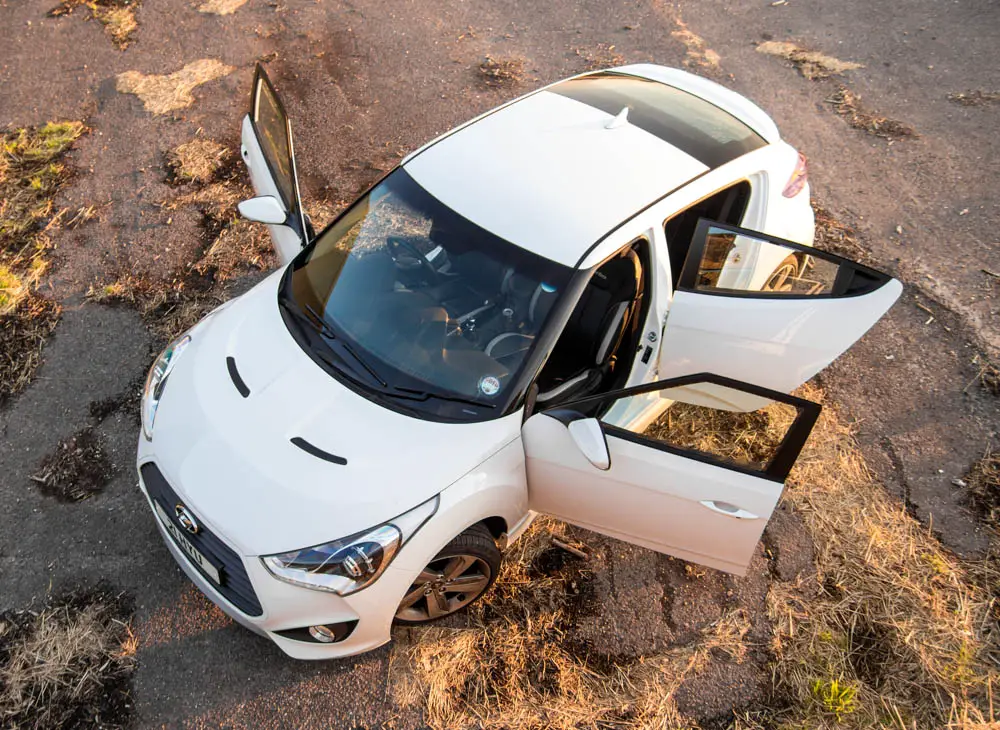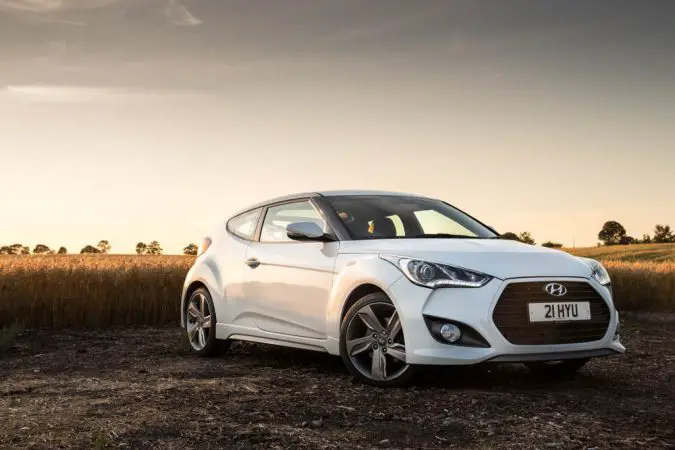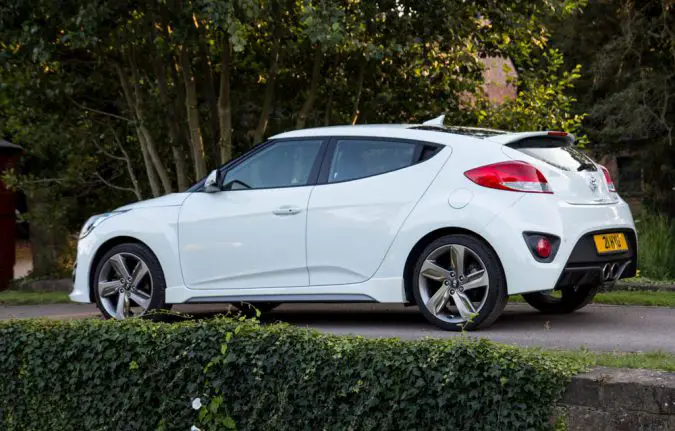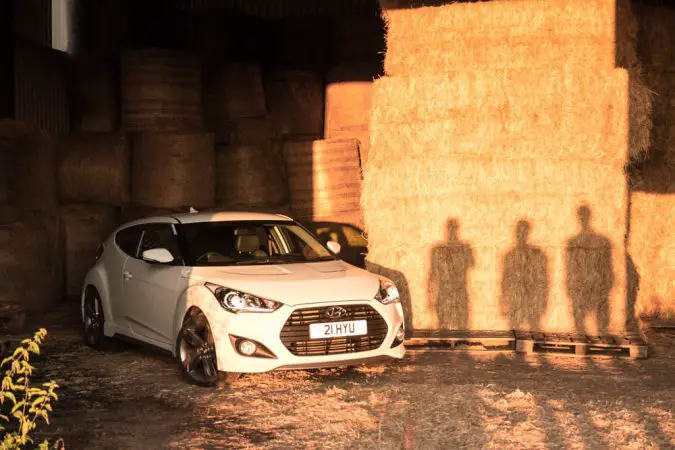If there’s one familiarity that every vehicle inherits from one another, that would be the doors. Some automobiles have 2 doors, while most have 4. Vans have sliding doors, while supercars have scissor doors. Every once in a while, carmakers break out of the even numbers, and refer to their cars as a 5 or 3 door, counting the rear hatch or tailgate. But what about a Hyundai 3 door car… Isn’t that odd?
The term “3-door” isn’t new, as many old hatchbacks can attest to. That’s 2 doors for the passengers, and another door at the back for the namesake hatchback. It isn’t as common these days as people seek maximal practicality with 4 big doors for each passenger. However, Hyundai’s stale past seems to have been eschewed for a more quirky, fun, and sporting future. This is how we got the Veloster.
It’s the first – and only production – Hyundai 3 door car, with room for 4, but only 3 doors to manage ingress and egress. The Veloster has garnered praise aplenty, either for its dynamic appearance, or the approachable athleticism that anyone can afford. Despite all that, its most fascinating and rather unique triple doors remain to be a highlight for many. So, what’s with this Hyundai 3 door car?
What’s The History With Hyundai’s 3 Door Veloster?
As we look at the oh-so-funky Hyundai 3 door car, we inevitably have to peek into Hyundai’s past as far as making performance cars go. After all, they got their start – and remain well-known till this day – for their uber-practical, economical, and affordable vehicles. Think of large SUVs, plush minivans, cozy sedans, or attainable crossovers. Only recently have they been practicing the art of making fun cars.
So, how is it that the once strictly conservative Hyundai executives signed off on designing, crafting, and engineering the uncharacteristically sporting Veloster in the first place? To be fair, though, this isn’t Hyundai’s first rodeo with performance-y vehicles. 3 years before the Veloster was announced, Hyundai was making the swoopy, sexy, speedy, and rear-wheel-driven Genesis Coupe in 2008.
Prior to that, Hyundai was then selling the Tiburon in the late 90s all the way to 2008. In other parts of the world, it was aptly named the Hyundai Coupe. While the Genesis Coupe was more upscale and lux, fitting for its grand-touring traits, the Hyundai Coupe was a proper little sports car. While it can’t compete on the same level as the JDM sports cars at the time, it did show what Hyundai could do.
This all culminated in the 2011 unveiling of the Veloster, filling the void left behind by the Tiburon. As the sportiest model in Hyundai’s line-up, its most prominent highlight was an asymmetrical 3 door configuration. The name “Veloster” is a portmanteau of ‘velocity’ and ‘roadster’. While it may not be a roadster – denoting an open-top 2-seater – it was undoubtedly had a sporty and dynamic design.
How Did Hyundai’s 3 Door Veloster Evolve As A Sporting Car?
The rest, as they say, is history. The Veloster remains in production, with plenty of updates that’ll be featured in the revamped 2022 model year Veloster. Hyundai’s unusual 3 door car had its roots in the 2007 Hyundai HND-3 concept. This concept was initially powered by a 2.0-liter Theta DOHC inline-4 engine and a 5-speed automatic. It also ran atop a modified Kia Cee’d front-wheel-drive platform.
And wow, did it change over these past few years. The Veloster was a bold and quirky addition to the Hyundai line-up, which is nonetheless antithetical to its boring past. Yet, the Veloster that we know is at its core, practical, economical, and affordable. Sound familiar? Yet, it’s also a pretty little car that can have ample performance to chuck it around and have fun with it. In all, it’s a proper hot hatch.
Enthusiasts can approach the Veloster’s performance, without having to pay a hefty price for it, too. For the most demanding of brand snobs that want a car to be built upon heritage, then consider that the Veloster’s racy siblings are among the most successful racing cars today. With championship wins in the IMSA touring car series worldwide, Hyundai has created an aspirational mystique around the Veloster.
Since then, Hyundai’s 3 door Veloster was sold across two generations, under the codename ‘FS’. So, here’s a quick overview of how this bizarre Hyundai 3 door car evolved over the years…
First-Generation Veloster (FS), 2011-2018
Hyundai’s 3 door Veloster came as a surprise when it launched in 2011. At the time, its styling was a strange departure from most of Hyundai’s contemporary line-up of 4-door sedans, minivans, SUVs, and crossovers. As a new sports hatchback, it garnered quite a lot of excitement, which is also helped by its low starting price of just $17,800 in the US. Yet, it featured a relatively luxurious interior cabin.
Better yet, the Veloster had a distinct look that nothing else on the market could match. And… It was sporty too, praised for its handling and fun factor. It wasn’t a surprise that besides the normal 3 door Veloster, a rally version was built alongside it, too. This was Hyundai’s commitment to motorsports, where they still dominate rally championships till this day with the i20. This is where it began.
Famed Red Bull Rallycross driver, Rhys Millen, had a chance to drive a rally version of the Veloster. Its 2.0-liter engine was retuned to produce more than 500hp and had an all-wheel-drive drivetrain to be best suited for traction-absent terrain. Starting in 2013, you can officially buy a ready-made Veloster rally car from Hyundai. Its novel Hyundai 3 door car layout wasn’t its only USP, therefore.
Understanding the desire for more performance, the beefed-up Veloster Turbo was released in 2012. It had increased horsepower and torque (more on those down below), as well as an enhanced grunt in the lower RPMs. Combined with a wide and aggressive body kit, along with its flared arches, larger front grille, and humungous twin exhausts, the Veloster Turbo was an affordable pocket rocket.
First-Generation Veloster Specifications
Engines:
- 1.6-liter gasoline inline-4 ‘Gamma’ MPi (fuel injection), with 128hp at 6,300RPM, and 116lb-ft of torque at 4,850RPM (2011-2018 model years)
- 0-62mph Acceleration: 10.7 seconds (manual) and 11.5 seconds (automatic)
- Top Speed: 121mph (manual) and 118mph (automatic)
- 1.6-liter gasoline inline-4 ‘Gamma’ GDi (gasoline direct injection), with 138hp at 6,300RPM, and 123lb-ft of torque at 4,850RPM (2011-2018 model years)
- 0-62mph Acceleration: 9.7 seconds (manual) and 10.3 seconds (DCT)
- Top Speed: 125mph (manual) and 124mph (DCT)
- 1.6-liter gasoline inline-4 ‘Gamma’ turbocharged (G4FJ twin-scroll turbo) GDi;
- 2012 to 2015 model year: 183hp at 5,500RPM, and 195lb-ft of torque peaking at 1,500 to 4,500RPM
- 0-62mph Acceleration: 8.4 seconds (manual) and 8.1 seconds (automatic)
- Top Speed: 133mph
- 2016 to 2017 model year: 201hp at 5,500RPM, and 195lb-ft of torque peaking at 1,500 to 4,500RPM
- 0-62mph Acceleration: 7.8 seconds (manual) and 7.4 seconds (automatic)
- Top Speed: 133mph
- 2012 to 2015 model year: 183hp at 5,500RPM, and 195lb-ft of torque peaking at 1,500 to 4,500RPM
Transmission:
- Manual, 6-speed (available with the 1.6 Gamma MPi, 1.6 Gamma GDi, and 1.6 Gamma Turbo GDi)
- Automatic, 6-speed (available with the 1.6 Gamma MPi, and 2012-2015 model year 1.6 Gamma Turbo GDi)
- Dual-Clutch (D6GF1), 6-speed (available with the 1.6 Gamma GDi)
- Dual-Clutch (D7UF1), 7-speed (available with the 2016-2017 model year 1.6 Gamma Turbo GDi)
Dimensions:
- Wheelbase:
- 104.3 inches (2,650mm)
- Length:
- 166.1 inches (4,220mm)
- 167.3 inches (4,250mm) for the Veloster Turbo
- Width:
- 70.5 inches (1,790mm)
- 71.1 inches (1,805mm) for the Veloster Turbo
- Height:
- 55.1 inches (1,400mm)
- Curb Weight:
- 2,425-2,756lbs (1,100-1,250kg)
- 2,646-3,086lbs (1,200-1,400kg) for the Veloster Turbo
Second-Generation Veloster (JS), 2018-Present
When it came time to update Hyundai’s 3 door car, the Veloster, the evolution was quite subtle. The asymmetrical 2+1 (or 3 passenger door) layout was unchanged, and the styling received some minor changes. Introduced in 2018, it did carry over a brand new design, which was more pronounced and aggressive compared to the more curvaceous first-generation Veloster. It had more tech, as well.
This included safety aids such as forward-collision with automated emergency braking, lane-keeping assist, and a driver attention monitor. There have been many tweaks under the hood, too. All models of the second-generation Veloster now get multi-link suspension as standard. This ought to improve its handling characteristics monumentally compared to the earlier couple torsion rear axles.
The addition of torque vectoring also upped its sporting credentials. A year later, the 3 door Veloster was rejigged into the more powerful Veloster N. This is the top-of-the-line performance equivalent to the old Veloster Turbo. Forming a core part of Hyundai’s new N division – akin to Mercedes’s AMG, or BMW’s M – the Veloster N had numerous touch-ups to yield enhanced athleticism.
Second-Generation Veloster Specifications
Engine:
- 2.0-liter gasoline ‘Nu’ inline-4 MPi (fuel injection), with 147hp at 6,200RPM, and 132lb-ft of torque at 4,500RPM
- 0-62mph Acceleration: 9.6 seconds (automatic)
- Top Speed: 129mph (automatic)
- 1.4-liter gasoline ‘Kappa II’ inline-4 T-GDi (turbocharged, gasoline direct injection), with 138hp at 6,000RPM, and 179lb-ft of torque at 1,500 to 3,200RPM
- 0-62mph Acceleration: 8.9 seconds (manual) and 9.2 seconds (DCT)
- Top Speed: 130mph (manual) and 127mph (DCT)
- 1.6-liter gasoline ‘Gamma II’ inline-4 T-GDi (turbocharged, gasoline direct injection), with 201hp at 6,000RPM, and 195lb-ft of torque at 1,500 to 4,500RPM
- 0-62mph Acceleration: 7.7 seconds (DCT)
- Top Speed: 140mph (DCT)
- 2.0-liter gasoline ‘Theta II’ inline-4 T-GDi (turbocharged, gasoline direct injection);
- 2018-Present: 247hp at 6,000RPM, and 260lb-ft of torque at 1,450 to 4,700RPM
- 0-62mph Acceleration: 6.4 seconds (manual)
- Top Speed: 155mph (manual)
- 2020-Present (Veloster N): 271hp at 6,600RPM, and 260lb-ft of torque at 1,450 to 4,700RPM
- 0-62mph Acceleration: 5.6 seconds (DCT)
- Top Speed: 155mph (DCT)
- 2018-Present: 247hp at 6,000RPM, and 260lb-ft of torque at 1,450 to 4,700RPM
Transmission:
- Manual, 6-speed (available with the 2.0 Nu MPi, 1.4 Kappa II T-GDi, 1.6 Gamma II T-GDi, and 2.0 Theta II T-GDi)
- Automatic (A6GF1), 6-speed (available with the 2.0 Nu MPi)
- Dual-Clutch (D7UF1), 7-speed (available with the 1.6 Gamma II T-GDi)
- Dual-Clutch (D8LF1), 8-speed (available with the 2.0 Theta II T-GDi)
Dimensions:
- Wheelbase:
- 104.3 inches (2,650mm)
- Length:
- 166.9 inches (4,240mm)
- 167.9 inches (4,265mm) for the Veloster N
- Width:
- 70.9 inches (1,800mm)
- 71.3 inches (1,810mm) for the Veloster N
- Height:
- 55.1 inches (1,400mm)
- 54.9-55.1 inches (1,395-1,400mm) for the Veloster N (dependent on the specifications)
- Curb Weight:
- 2,723-2,899lbs (1,235-1,315kg) for the 2.0 Nu MPi
- 2,800-2,976lbs (1,270-1,350kg) for the 1.4 Kappa II T-GDi and 1.6 Gamma II T-GDi
- 3,036-3,252lbs (1,377-1,475kg) for the Veloster N (2.0 Theta II T-GDi)
What About The 2022 Model Year Hyundai 3 Door Veloster?
Earlier in July 2021, Hyundai announced that the regular Veloster hatches will no longer be sold in the USA, owing to poor market demand. As of right now, the only Veloster that you can buy from dealers brand-new is the hotter Veloster N. It forms a core part of Hyundai’s N range for US customers, which sit alongside the Kona N crossover-SUV, as well as the Elantra N sedan that’s bound to arrive soon.
With a starting price of $32,500, it’s comfortably competitive in a hot hatchback market filled to the brim with the likes of the Golf GTI, Golf R, Civic Type R, Ford Focus RS, and more. In addition, the price gets you a sprightly 2.0-liter turbocharged inline-4, as we’ve noted earlier, with 275hp. Paired to that is a rapid 8-speed wet dual-clutch transmission for quick and smooth shifts.
Although, if you’re a bit more old-school, a 6-speed manual gearbox remains available, including an automatic rev-matching system. The Veloster N is highly configurable, which allows you to set up the car however you want it. Between its selectable drive modes, you can pick higher performance, more aggressive gearshifts, louder exhausts, faster steering, harder suspension, or looser traction control.
Another attractive addition in the Veloster N is an electronic limited-slip differential (eLSD). This too, you can configure to make your Hyundai 3 door car to improve its handling and cornering speeds. It’s matched with an aggressive body kit all-around to improve its aerodynamics. This is contrasted with the multitude of driver aids and active safety systems to keep you alert of what’s around you.
Does The New Hyundai 3 Door Veloster Go Racing Anymore?
Indeed, it does! This unorthodox Hyundai 3 door car does go racing still, after all these years. Hyundai participates in several motorsport categories, and the Veloster is among its most competitive cars. It competes alongside the Hyundai i20 N, i30 N, and Elantra N race cars, respectively. Hyundai’s active genres of racing include rallying (in the World Rally Championship), and touring cars (or TCR).
80% of the Veloster N TCR’s componentry are shared with the tried and tested i30 N TCR. There, the Veloster N TCR was built and tested at Hyundai’s motorsport proving grounds in Alzenau, Germany. That’s quite a distance from the city of Namyang – where Hyundai got the ‘N’ from – in South Korea that is Hyundai’s main research and development facility. Highlights of the Veloster N TCR include:
- Engine: 2.0-liter turbocharged inline-4, cranking out 350hp and 450Nm (around 332lb-ft) of torque at 3,500RPM (it peaks at a screeching 7,000RPM)
- Layout: Front-wheel-drive (with a multi-plate limited-slip differential)
- Transmission: 6-speed sequential gearbox (with paddle shifters), with a twin-disc racing clutch
- Suspension: McPherson struts in the front, with 4-arm multi-link axles in the rear
- Brakes: 6-piston calipers in the front (ventilated steel discs), with 2-piston calipers in the rear (ventilated steel discs)
Nevertheless, Hyundai continued the evolve the Veloster’s racing entry with the new and improved Veloster N ETCR. That ‘E’ in front of TCR will be among the first all-electric touring car racing series. As such, the Veloster N ETCR has been modified to accommodate a rear-wheel-drive setup, with a set of mid-mounted electric motors. 4 of them, in fact – 2 motors for each rear wheel – for up to 670hp.
Why Is The Hyundai Veloster A 3 Door Car?
The elephant in the room on top of everyone’s mind is no doubt… Why? Why did Hyundai make the Veloster a 3 door car instead of a more conventional 2 or 4 door? Ah, their justification for this weird 2+1 door situation is that you can (theoretically) gain the benefits of both a 2 door sports car and a 4 door hatchback. It looks like a sports car on one side, while it remains a practical cruiser on the other.
Granted, Hyundai’s Veloster isn’t the first to tease with this idea, as Mini did that with the Clubman. It had bi-parting side doors which, unfortunately, only open on the right-hand side, regardless of the region. That’s fine if you’re in the US-of-A, where passengers enter and exit the car on the right. But if you’re in the right-hand-drive UK or elsewhere, passengers would enter and exit into oncoming traffic.
Meanwhile, Hyundai solved this with region-specific side doors fit for both left- and right-hand drive markets. This way, the passengers will always depart or arrive on the curb-side of the vehicle. A note on those doors, by the way, they’re not the same size on the Veloster. The singular driver-side door is always larger and longer than the double passenger doors. Here’s what Hyundai wanted to replicate:
2 door vehicles:
- They appear more exotic and sporty and give the illusion that the car is shorter than it seems.
- Anyone who’s sitting in the front and rear can enjoy a better view out, as there’s less door to obstruct the windows.
4 door vehicles:
- They’re more practical, and enable simpler access to the rear seats, such as loading cargo or luggage.
- It makes ingress and egress easier (and less embarrassing) for rear passengers compared to a 2 door vehicle.
What Are The Benefits Of Hyundai’s 3 Door (2+1) Configuration?
Seeing the aforementioned upsides of both 2 and 4 doors vehicles, Hyundai sought to find a comfy middle ground with its 2+1 door design. Hence, the arrival of a Hyundai 3 door car in the form of the Veloster. It may continue to sharply divide opinion, but Hyundai is quite proud of this, shown by their persistence to keep the Veloster as-is in their line-up. There are a couple of pros to this, certainly:
- Occupant Safety – Remember how we mentioned that the passenger doors – specific to each region – will always open only on the curb-side? This does aid in improving safety, as it means passengers will not be able to exit the car on the side of oncoming traffic. Consequently, this prevents them from the possibility of opening the doors without looking and thus getting clipped by a passing vehicle.
- Driver’s Convenience – The driver benefits from this Hyundai 3 door car design, as well. The driver’s doors are larger, longer, and more swooping, like that on a sporty coupe. This is a more comfortable and ideal door-opening for the driver to get in and out of. Moreover, the longer doors mean that the B-pillars are further back. As a result, this helps to improve side and rearward visibility.
Of course, we can joke about its many inconveniences, too. As the driver, it means that you’re having to circle around the entire car just to access the rear seats from your side. Oh, and let’s not mention the confusion you’ll get from passers-by being like, “wait, how many doors does it have?”. But then again, you can be proud that you own a Veloster, as it still is one of the coolest cheap cars to date.
Facts: Why the Hyundai Veloster has Three Doors
- The Hyundai Veloster is a sporty three-door coupe that has an asymmetrical design, which has divided fans and critics.
- The asymmetrical design of the Veloster is the most commonly asked question about the car.
- Hyundai has not provided an official reason for the design, leaving it up to engineers and drivers to speculate.
- The two primary conclusions for the asymmetrical design are safety for passengers and convenience for the driver.
- The asymmetrical design is believed to enhance safety by preventing passengers from exiting on the side facing the street.
- The long, coupe-like driver-side door of the Veloster provides comfortable entry/exit and better visibility.
- The Veloster is a compromise between the spirit of a coupe and the practicality of a hatchback.
- The rear door on one side of the Veloster is rarely used since the car is designed for transporting fewer passengers.
- The Veloster’s design offers better access to the back row than a coupe without detracting from the driver’s daily experience.
- The Veloster offers a clever alternative to assumed standards by offering a unique design.
Final Thoughts On Hyundai 3 Door Cars
Despite how small the Veloster may appear though, you’d be surprised just how much room you get in the back of it. Of course, it won’t be able to offer as much interior space as a comparably priced crossover or SUV. Smaller cars like the Veloster are a rarity, but I think we should appreciate it while we still have them. So, should you buy this funky Hyundai 3 door car? It gets a solid Yes from me.
We’ve featured it a couple of times here already. Most recently, we’ve highlighted the poor reliability of earlier Veloster model years, and some tips on how to get a good one. In summary, the first years of the Veloster was a bumpy start for the marque, owing to numerous issues. But find a later model, and you’ll be assured to have a relatively headache-free ownership. They’ve only improved since!
Furthermore, we also made mentions of the Veloster in our guide of the fastest cars that you can get for under $30,000. The Veloster Turbo, in particular, scored quite well. Despite the “boring” Hyundai badge, any Veloster – especially the super-spicy N variant – is a speedy car. Not only in a straight line, mind you, as the Veloster is dynamically a strong contender among the best hot hatches today.
If you’re going to look at this Hyundai 3 door car from a more practical point of view, the newer cars have an abundance of technology. From a slick infotainment to class-leading driver aids, it can make you a happier and safer driver. And, it barely sips on any fuel. In all, this Hyundai 3 door car ought to be loved for more than just its odd triple-door layout. It’s proof that cheap cars can be magnificent!




